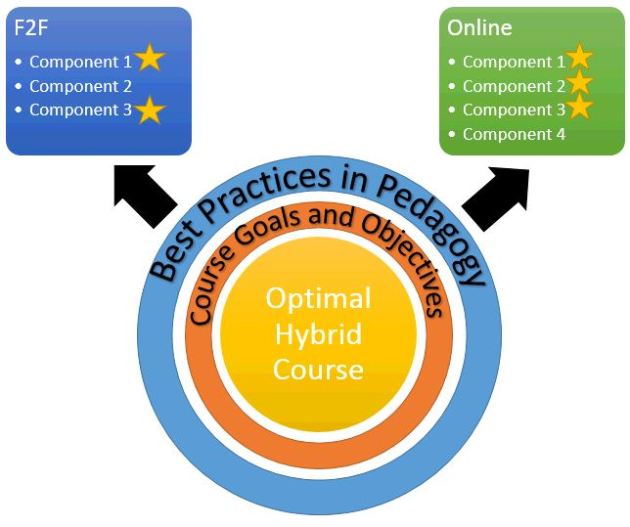As I continue to come up with a definition of hybrid courses or at the very least how to put adjectives to the noun I'm trying to get a handle on, here's a first attempt. What do you think?
A Definition: Hybrid courses leverage the best of what traditional face-to-face instruction offers with the flexibility, power, and accessibility of online instruction. Merely taking elements of both and throwing them together into a course does not embody the best representation of a hybrid course any more than throwing a bunch of diverse components together to form a hybrid vehicle. Rather, the intent behind building a hybrid course is to take into consideration course goals and objectives, best practices in pedagogy, appropriate face-to-face methods and available technologies to create a course whose individual components work together synergistically – by design, not by coincidence.
 Decisions about course design are driven primarily by the course goals and objectives. Courses can go lots of places and directions - and inevitably they will, even if they have a great instructor, but if they're not designed with a particular end or target in mind the end point may not be the intended destination. There are thousands of books, articles, papers and peer-reviewed research that points to the importance of pedagogy. Highlighting the goals of a course against the backdrop of a proven and relevant pedagogy sets the course up for the addition of the next to elements: face-to-face methods and online technologies. Using course objectives as a lens and pedagogy as a mirror, instructors/designers should then take into consideration the differing components of face-to-face and online instruction.
Decisions about course design are driven primarily by the course goals and objectives. Courses can go lots of places and directions - and inevitably they will, even if they have a great instructor, but if they're not designed with a particular end or target in mind the end point may not be the intended destination. There are thousands of books, articles, papers and peer-reviewed research that points to the importance of pedagogy. Highlighting the goals of a course against the backdrop of a proven and relevant pedagogy sets the course up for the addition of the next to elements: face-to-face methods and online technologies. Using course objectives as a lens and pedagogy as a mirror, instructors/designers should then take into consideration the differing components of face-to-face and online instruction.
It's often here that most instructors/designers get hung up. Everything seems to get pinned on the answer to the question: "What do I do online and what do I do face-to-face?" The answer to the question is not unlike the answers King Arthur's knights had to give at the crossing of the Bridge of Death - they will were different, but they were all true - that is for those who made it across the bridge.
The easiest thing to do would be to determine all the various types of face-to-face methods that could be used, alongside all the technologies that online could provide and align them with the course goals and objectives. I'll grant that course design this way requires an extensive amount of work, especially going into the course. It requires the instructor/designer to have an awareness not only of the content to be taught, but also to be aware of who they will be teaching, the context in which they'll be teaching, and to be well practiced in good pedagogy and the available technology.
I spent a bit of time growing up in Europe, and one of the things that always fascinated me was the majestic and towering character of the church buildings there. My impression of each of them always left me thinking how precise and intentional the builders had to have been. The Sistine Chapel with it's awe-inspiring back-story (whose designer) had many, many design talents - surly had to have been intentional about how he pulled together the strengths of each element he employed in his work.
I can't imagine that the work of course designers/instructors should be any less when constructing a blended course, or any course in general for that matter.
Crossposted from: http://wp.me/p2JLSQ-EV
Comment
© 2026 Created by Steve Hargadon.
Powered by
![]()

You need to be a member of Classroom 2.0 to add comments!
Join Classroom 2.0